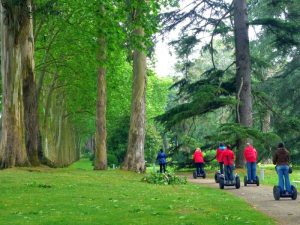
Embark on a journey through Sustainable countryside tourism experiences, where eco-friendly adventures await at every turn. Get ready to discover the beauty of rural landscapes while supporting local communities and preserving the environment in this exciting exploration of sustainable travel.
As we dive deeper into the concept of sustainable countryside tourism, we unveil the significance of responsible travel practices and the positive impact they can have on both the local communities and the natural surroundings.
Sustainable Countryside Tourism Experiences
Sustainable countryside tourism refers to a type of tourism that focuses on preserving the natural environment, promoting local culture, and benefiting the local communities while minimizing negative impacts on the ecosystem.
It is essential to implement sustainable practices in rural tourism to ensure the long-term viability of the destination and protect the environment. By incorporating eco-friendly initiatives, reducing waste, conserving energy, and supporting local businesses, sustainable countryside tourism can help preserve the natural beauty of the area and maintain its cultural authenticity.
Importance of Sustainable Practices
- Promotes environmental conservation and biodiversity protection
- Preserves cultural heritage and traditions
- Supports the local economy and creates job opportunities
- Enhances the overall visitor experience by offering unique and authentic activities
Domestic Travel
Domestic countryside travel offers tourists a chance to explore the natural beauty and culture of their own country. It provides a sense of connection to the land and the people, creating a unique and authentic experience.
When compared to urban tourism experiences, domestic countryside travel allows tourists to escape the hustle and bustle of city life and immerse themselves in a more peaceful and serene environment. It offers a chance to relax, rejuvenate, and appreciate the simplicity of rural living.
Sustainable Initiatives in Domestic Countryside Tourism
- Implementing eco-friendly accommodation options such as solar-powered lodges or sustainable farm stays.
- Promoting local and organic food production to support small-scale farmers and reduce carbon footprint.
- Developing walking or cycling tours to minimize the use of motorized vehicles and encourage active exploration of the countryside.
- Engaging with local communities to ensure that tourism benefits are shared equitably and contribute to the preservation of cultural heritage.
International Travel

International tourists are increasingly seeking sustainable countryside experiences as a way to connect with nature, culture, and local communities. This growing trend highlights the appeal of authentic and eco-friendly travel options that allow visitors to immerse themselves in the beauty of rural landscapes while supporting conservation efforts and local livelihoods.
Challenges and Opportunities
- Challenges:
- Language barriers: Communication can be a hurdle in promoting sustainable rural tourism internationally.
- Infrastructure: Developing countries may lack the necessary infrastructure to support a large influx of tourists.
- Cultural sensitivity: Ensuring that tourists respect local customs and traditions is crucial for sustainable tourism.
- Opportunities:
- Market differentiation: Offering unique and authentic experiences can attract discerning travelers looking for sustainable options.
- Community empowerment: Engaging local communities in tourism initiatives can lead to economic benefits and cultural preservation.
- Collaboration: Partnering with international organizations and tour operators can help promote sustainable countryside tourism on a global scale.
Economic Impact
Sustainable countryside tourism can have a significant economic impact on rural communities by generating income, creating job opportunities, and supporting local businesses. International tourists who choose sustainable travel options often spend more on authentic experiences, accommodations, and locally-made products, contributing to the overall economic development of rural areas. This boost in tourism revenue can help diversify local economies, reduce poverty, and improve infrastructure, making a positive impact on the livelihoods of residents in the countryside.
Urban Travel
When it comes to urban travel versus countryside tourism, there are significant differences in the experiences offered to visitors. Urban travel often involves bustling cities, modern amenities, and a fast-paced lifestyle, while countryside tourism focuses on nature, tranquility, and a slower pace of life.
Contributing to Sustainable Practices
Urban travelers can contribute to sustainable practices during countryside visits by being mindful of their environmental impact. This can include reducing waste, conserving water and energy, and supporting local conservation efforts. By choosing eco-friendly accommodations, participating in responsible wildlife viewing activities, and respecting the local culture and traditions, urban travelers can help preserve the natural beauty and resources of rural areas.
Supporting Local Communities
There are several ways in which urban travelers can support local communities in rural areas. One way is to shop locally and purchase handmade crafts or products from local artisans. This not only helps to boost the local economy but also preserves traditional crafts and skills. Additionally, urban travelers can engage in community-based tourism initiatives, such as homestays or cultural exchanges, to directly support local families and communities.
By immersing themselves in the local culture and customs, urban travelers can create meaningful connections and contribute to the sustainable development of rural areas.
Countryside Exploration
Exploring the countryside offers a unique opportunity to connect with nature, experience local culture, and escape the hustle and bustle of city life. To make the most of your countryside exploration, here are some tips to keep in mind:
Embrace the Slow Pace
Countryside living is all about taking things slow. Allow yourself to relax, unwind, and immerse yourself in the tranquility of rural life.
Interact with Locals
One of the best ways to truly experience the countryside is to engage with the locals. Learn about their traditions, customs, and way of life.
Try Local Cuisine
Explore the local food scene and savor traditional dishes made with fresh, locally sourced ingredients. Don’t be afraid to try something new!
Opt for Sustainable Accommodation
Choose eco-friendly lodging options such as farm stays, eco-lodges, or guesthouses that support local communities and minimize environmental impact.
Activities in Rural Areas
When it comes to countryside exploration, there is no shortage of activities to enjoy. Here are some popular options for tourists in rural areas:
- Hiking and Nature Walks: Discover scenic trails, lush forests, and breathtaking landscapes on a leisurely hike or nature walk.
- Farm Visits: Get a taste of farm life by visiting local farms, participating in agricultural activities, and learning about sustainable farming practices.
- Wildlife Watching: Explore the diverse flora and fauna of the countryside through birdwatching, wildlife safaris, or nature photography.
- Cultural Experiences: Immerse yourself in the local culture through traditional performances, craft workshops, and visits to historical sites.
Respect the environment, wildlife, and local customs during your countryside exploration to ensure a positive impact on the community and ecosystem.
Island Travel
Island travel offers unique sustainable tourism opportunities that showcase the beauty of these secluded destinations while promoting environmental conservation.
Balancing Tourism Development with Environmental Conservation on Islands
One of the main challenges of island travel is finding the delicate balance between tourism development and environmental conservation. Islands are often fragile ecosystems that can be easily disrupted by large numbers of visitors and infrastructure development. It is crucial for sustainable island tourism initiatives to prioritize conservation efforts to protect the natural beauty and biodiversity of these unique destinations.
- Implementing strict regulations on development to prevent overbuilding and habitat destruction.
- Encouraging responsible tourism practices such as waste reduction, water conservation, and supporting local communities.
- Creating marine protected areas to preserve coral reefs and marine life from the negative impacts of tourism activities.
Success Stories of Sustainable Island Tourism Initiatives
Despite the challenges, there are success stories of sustainable island tourism initiatives that have managed to thrive while preserving the environment.
One example is the Seychelles, which has implemented eco-friendly practices in its tourism industry, such as sustainable fishing, renewable energy use, and protected marine areas.
| Island Destination | Initiative |
|---|---|
| Bhutan | Carbon-negative tourism policies |
| Palau | Creation of the world’s first shark sanctuary |
| Galapagos Islands | Strict regulations on visitor numbers and activities to protect the unique biodiversity |
Closing Summary

In conclusion, Sustainable countryside tourism experiences offer a gateway to immersive travel opportunities that not only enrich the lives of visitors but also contribute to the preservation of our planet. By embracing sustainable practices, we pave the way for a brighter future where tourism and conservation go hand in hand.
Expert Answers
What exactly is sustainable countryside tourism?
Sustainable countryside tourism focuses on promoting responsible travel practices in rural areas, aiming to minimize negative impacts on the environment and support local communities.
How can tourists contribute to sustainable countryside tourism?
Tourists can contribute by choosing eco-friendly accommodations, supporting local businesses, and participating in activities that respect the local culture and environment.
Why is sustainable rural tourism important?
Sustainable rural tourism is important as it helps preserve the natural beauty of countryside areas, uplifts local economies, and educates visitors on environmental conservation.





